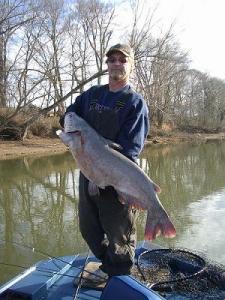Post
Catfish and Carp
Bait & Scent Articles, Catfish and Carp Fishing, Freshwater Fishing Articles BFT-Editor -TMH PM

Catfish and Carp Facts and Baits to Catch Them
Some fish prefer live bait, others like artificial lures, and many species will even eat cut bait. But the catfish is one of the few, if not the only one that will eat almost anything.
Its willingness to gobble up whatever it finds on the bottom has been the undoing of many a catfish.
Catfish come in all sizes, live in any kind of water and seem to be hungry all the time.
You can catch catfish from 5 or 6 inches long to 9 feet long. They weigh anywhere from a few ounces to well over 100 pounds.
From dwarf-sized ones to the monsters found in Europe, they come in a rainbow of colors, including yellow, blue, brown, silver, white, redtail, speckled, spotted, and others.
Catfish go by all sorts of names: mud, bullhead, flathead, flatnose, electric, granny, gravel, oceanic, sea, walking, squaretail, Russian and Mississippi.
Catfish can be found in small ponds, creeks, lakes, rivers and swamps, as well as in the ocean. Walking catfish have learned to survive by using their fins to walk on land when swamp ponds dry up, to find more water.
They aren’t too particular about what they eat, which includes night crawlers, frozen shrimp, catalpa worms, chicken livers, stink baits, cut-up bait fish, live bream and minnows.
You can catch the bottom-feeding fish on light tackle off the bank simply by casting your bait into the water and letting it sit on the bottom. Many people use a cork or bobber to signal when the fish are biting.
It may take a little time to learn when to set the hook, but the tasty fish are not only willing to bite, they taste good when sauteed in a frying pan.
Catfish are ideal for young children trying to learn to fish because they are easy to catch and there’s nothing for a child like eating a fish he or she caught.
At the other end of the scale, guides for the big Arkansas blues and flathead catfish use heavy line and tackle because these big ones are strong and can easily break smaller line.
Catfish bite just as well when the water is muddy as when it’s clear. The same baits and lures work well around piers, channels and other structure.
Home made baits
Cheese balls, chicken livers and grits cooked in Pepsi are just a few of the baits used to catch catfish, carp and other bottom-feeding fish.
There must be as many concoctions for homemade baits as there are artificial lures. And everyone knows there must be as many artificial lures as there are anglers to fish with them.
Live bait is popular for catching bass, bream, crappie, catfish, stripers and almost any other kind of fish you can think of.
The grits and Pepsi mixture is one of many. Fill the pan with Pepsi, bring to a boil, add grits and cook until thick. Mold around the hook and cast into the water.
The carp you catch may be a new state record.
Before you laugh too much, remember that carp and catfish grow much larger than the bass, stripers and crappie all you purists are catching.
Catfish seem to love chicken livers and other combinations that have plenty of odor.
There are plenty of commercial baits for catfish and carp on the market. Vienna sausage has always been a special bait for bottom feeders, and some anglers use the new small link-type sausages to catch catfish and carp.
Both catfish and carp are two of the hardest fighting fish to be caught from freshwater. With their hefty size, they can offer a real strong workout for the experienced angler.
Tackle intended for bream, crappie or even big bass should not be considered for such quarry as catfish or carp. Heavier line and rods are the minimum upgrade required, and larger reels would be a good idea.
How to clean a catfish as you catch it
Want a mess of catfish for dinner? Try this tip. Ivory soap.
Catfish will eat just about anything – chicken livers, specially prepared commercial baits, gizzards, worms and just about anything else you can get to stick on the hook.
Some fishermen in the Carolinas have been known to use Ivory soap as bait. You simply heat the soap in warm water until it begins to melt and drain the water.
You then take the melted soap and mold it on small treble hooks and use it for bait. The soap dissipates odor through current running over the soap, leading the catfish to the bait.
